The Beijing News (Reporter Dai Xuan): Overweight and obesity have become one of the major public health issues affecting the health of primary and secondary school students. Recently, the National Health Commission, the Comprehensive Department, and the General Office of the Ministry of Education jointly issued the “Guidelines for Comprehensive Public Health Prevention and Control of Overweight and Obesity in Primary and Secondary School Students.”
The guidelines point out that overweight and obesity have become one of the major public health issues affecting the health of primary and secondary school students, requiring the attention of the entire society. Implementing a three-level preventive strategy of prevention, early intervention, and disease warning is key to comprehensive prevention and control of overweight and obesity in primary and secondary school students, promoting comprehensive development.
The main factors influencing overweight and obesity in primary and secondary school students include genetics, behavior, environment, and social factors, which are collectively influenced and interacted by the above various factors. Among them, dietary nutrition, physical activity, lifestyle, and mental health are key individual factors, while food systems, urban planning and living environment, public policies, and management are important environmental and social determinants.
Under the guidance of professional institutions, schools and parents are encouraged to use the “Risk Self-Assessment Form for Overweight and Obesity in Primary and Secondary School Students” (see appendix) to assess the risks of individual and group overweight and obesity, including diet, physical activity, and parental obesity. Early identification of high-risk individuals for overweight and obesity provides a basis for targeted diet and physical activity interventions.
Promoting healthy eating habits. Encourage families and schools to provide a variety of foods with reasonable combinations, including more vegetables, fruits, dairy products, whole grains, legumes, soy and its products, and adequate amounts of fish, poultry, eggs, lean meat. Gradually reduce salt, oil, and added sugar in cooking. Guide students to eat regularly and moderately, have a good breakfast every day, reduce eating out, choose snacks wisely, consume less or no sugary drinks, and drink plenty of water. Advocate for creating a good dining atmosphere in families, cultivate the habit of children focusing on eating without distractions from activities like watching TV or using electronic devices.
Ensure physical activity. Encourage schools to provide one physical education class per day, ensuring students have ample physical activity during major breaks and intervals. Students should engage in physical activities daily for at least 1 hour of moderate to vigorous intensity, with outdoor activities as a priority. Engage in muscle-strengthening and/or bone-strengthening activities at least 3 days a week, actively participate in simple and convenient exercises like running, playing sports, fitness programs, and skipping ropes to normalize physical activity. Guide parents to instill exercise habits in children, accompany and exercise with them. Reduce sedentary behavior and screen time, stand up and move after sitting for 45 minutes, limit screen time to less than 2 hours per day, and ensure adequate sleep.
Professional institutions should guide schools to conduct monitoring of overweight and obesity in primary and secondary school students in conjunction with health check-ups. Establish student health records, provide timely feedback on check-up results to parents, guide parents to monitor and regularly assess changes in student weight. During student health check-ups, it is recommended to equip with height measuring instruments and weighing scales that meet the requirements of the “Technical Specifications for Student Health Examination” (GB/T 26343-2010), screen overweight and obesity in primary and secondary school students based on age- and gender-specific body mass index (BMI) criteria, and assess overweight and obesity status based on waist circumference, body composition, and other indicators.
Professional institutions should evaluate the prevalence of overweight and obesity in local primary and secondary school students based on health check-up screening and assessment results. For students already overweight or obese, provide early warnings based on comprehensive assessments, promptly inform schools and parents. Parents are advised to monitor the weight of overweight and obese students weekly, regularly measure indicators such as blood pressure, blood sugar, blood lipids, and uric acid, and seek guidance and services from medical institutions based on measurement results and changes.
For severely obese students or those with clinical risk factors, comprehensive interventions involving medical and health, dietary, exercise, psychological, and behavioral corrections should be carried out in accordance with relevant guidelines.
Editor: Zhang Qian
Proofreader: Jia Ning


